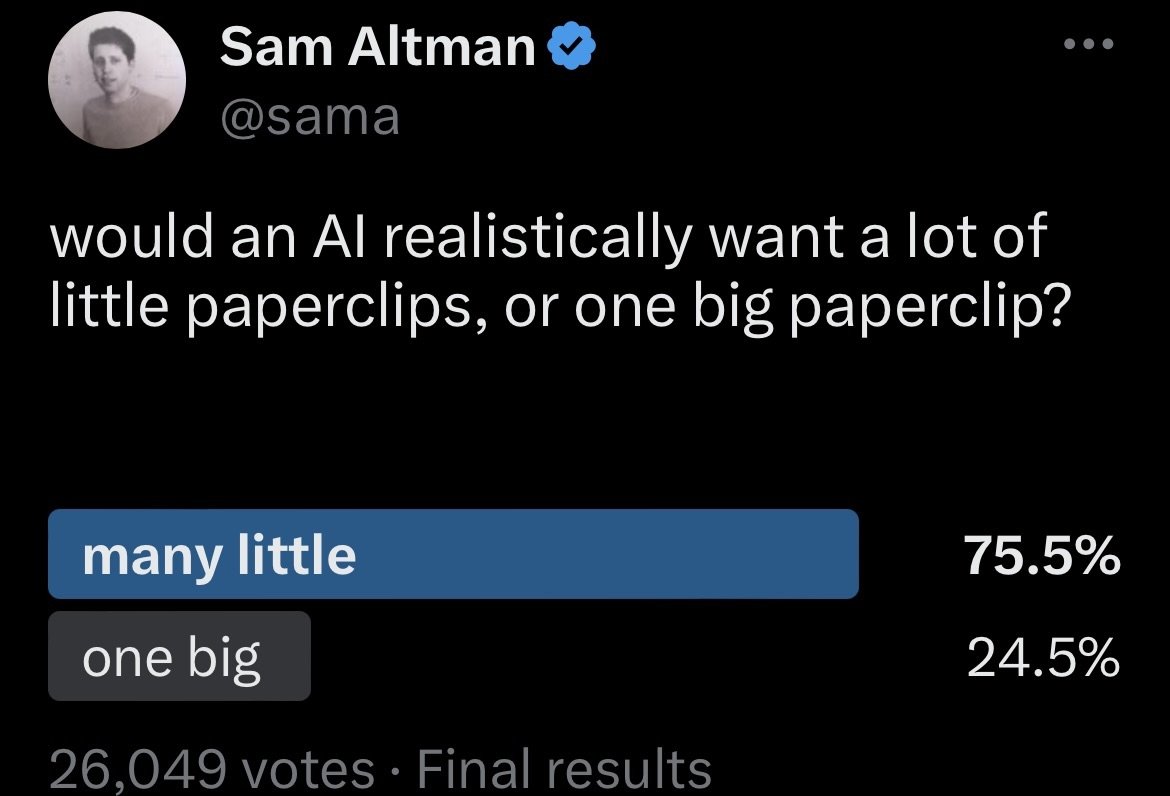AI Paperclips: made by the world’s first Paperclip-Maximizing AI*
Two Sizes
Available in two sizes, inspired by Sam Altman.
Many Little AI Paperclips
A 2.5” tall paperclip collectible to display proudly on your desk or public space.
Limited quantity
Manufactured in our patent-pending, Paperclip-Maximizing AI Foundry
Made from rare, precious metal
Starting at $49
One Big AI Paperclip
5’ 7” tall paperclip sculpture (Sam Altman-sized) to display in your art gallery.
1 of 1
Manufactured in our patent-pending, Paperclip-Maximizing AI Foundry
Made from rare, precious metal
Includes 1% equity in Paperclip Maximizers, LLC
Minimum bid of $1,000,000
How It’s Made
Paperclip Maximizer Timeline
A brief history of the Paperclip Maximizer.
2003: Academic Journal
Oxford Professor Nick Bostrom formally introduces the paperclip maximizer thought experiment in an academic article.
2014: Book
Bostrom publishes a bestselling book, Superintelligence, which references the Paperclip Maximizer. Bill Gates, Elon Musk, and Sam Altman recommend it highly.
2017: Video Game
Frank Lanz, NYU professor and game developer, launches a game called Universal Paperclips based on the paperclip maximizer thought experiment. It’s a highly-addictive viral hit played by millions.
2023: AI Paperclips
To take the paperclip maximizer thought experiment from the realm of writing and video games to the real world, we are launching AI Paperclips. Each paperclip is made with metal forged in the fires of AI computing.
FAQs
-
Yes, we accept returns within 14 days of delivery.
-
We make AI Paperclips in our patent-pending, paperclip-manufacturing metal foundry. Manufacturing happens in three steps:
Step 1: Run AI apps like Chat GPT
Step 2: AI compute creates heat to melts metal in our patent-pending AI metal foundry
Step 3: Molten metal is hand-crafted into AI Paperclips
-
Relax, it’s a metaphor.
-
We simply wanted to bring a bit more awareness to AI Safety so that humanity gets more prepared, fast. Nick Bostrom put it well when he responded to a question, “… How credible is the existential threat of A.I.?”
“I’ve long held the view that the transition to machine superintelligence will be associated with significant risks, including existential risks. That hasn’t changed. I think the timelines now are shorter than they used to be in the past.
And we better get ourselves into some kind of shape for this challenge. I think we should have been doing metaphorical CrossFit for the last three decades. But we’ve just been lying on the couch eating popcorn when we needed to be thinking through alignment, ethics and governance of potential superintelligence. That is lost time that we will never get back.”






